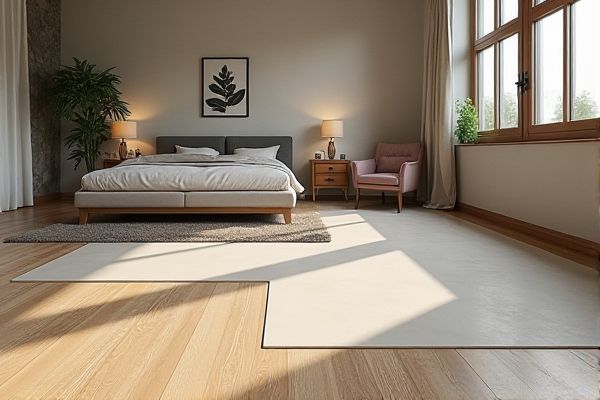
Single layer flooring offers a straightforward installation with moderate durability and cost-effectiveness, ideal for low-traffic areas or quick renovations. Double layer flooring enhances strength, insulation, and longevity, making it a superior choice for high-traffic spaces or homes requiring extra support; explore the article to understand which option best suits your flooring needs.
Table of Comparison
| Feature | Single Layer Flooring | Double Layer Flooring |
|---|---|---|
| Structure | One layer of material | Two layers of material stacked |
| Durability | Moderate, suitable for low traffic | High, ideal for heavy traffic areas |
| Installation Cost | Lower cost | Higher cost due to extra layer |
| Sound Insulation | Limited sound absorption | Improved sound insulation |
| Moisture Resistance | Basic resistance | Enhanced moisture protection |
| Maintenance | Easier and cheaper to maintain | Requires more care, but longer lifespan |
| Use Case | Residential or low traffic commercial | Commercial, industrial, or high traffic residential |
Introduction to Single Layer vs Double Layer Flooring
Single layer flooring consists of a single material layer, offering simpler installation and cost-effectiveness, while double layer flooring incorporates two distinct layers, providing enhanced durability and improved sound insulation. Your choice depends on factors like budget, usage requirements, and desired performance, as double layer flooring typically offers greater resistance to wear and better thermal insulation. Understanding these differences helps optimize flooring decisions for both residential and commercial spaces.
What Is Single Layer Flooring?
Single layer flooring consists of one uniform material that provides a consistent surface and structural support, making it ideal for simpler installations and cost-effective projects. This type of flooring typically includes materials like laminate, vinyl, or engineered wood, offering durability and ease of maintenance. Your choice of single layer flooring can balance affordability with aesthetic appeal, depending on the quality and finish selected.
What Is Double Layer Flooring?
Double layer flooring consists of two distinct layers: a solid subfloor and a separate topwearing surface, offering enhanced durability and sound insulation compared to single layer flooring. This design helps distribute weight more evenly and minimizes the impact of moisture or temperature fluctuations on the floor's integrity. If you seek long-lasting protection and improved comfort, double layer flooring is a superior choice versus single layer options.
Material Composition and Structure
Single layer flooring consists of a uniform material, such as solid hardwood or laminate, providing consistent density and straightforward installation. Double layer flooring incorporates two distinct layers, often a plywood or composite base topped with a hardwood veneer, enhancing stability, durability, and resistance to moisture. The structural design of double layer flooring reduces expansion and contraction compared to single layer flooring, making it ideal for unpredictable environmental conditions.
Installation Process Comparison
Single layer flooring installation involves laying one continuous material, making the process quicker and less labor-intensive, ideal for straightforward applications. Double layer flooring requires installing a base layer for structural support followed by a top layer for aesthetics and durability, resulting in a more complex and time-consuming procedure. You should consider the increased installation time and expertise needed for double layer flooring to ensure a long-lasting and high-quality finish.
Cost Differences: Single vs Double Layer
Single layer flooring typically costs less due to fewer materials and simpler installation processes, making it an economical choice for basic applications. Double layer flooring involves additional underlayment or a secondary wear layer, increasing both material and labor expenses, but enhancing durability and insulation. Your choice depends on budget constraints and desired long-term performance benefits, with double layers offering greater value despite the higher initial cost.
Durability and Lifespan
Single layer flooring typically offers moderate durability, with an average lifespan of 10 to 20 years depending on the material and maintenance, making it suitable for low to medium traffic areas. Double layer flooring enhances durability significantly by combining a wear-resistant top layer with a robust underlayer, often extending the lifespan to 25-40 years or more. This layered construction provides superior resistance to impact, moisture, and wear, ideal for high-traffic commercial or residential environments seeking long-term flooring solutions.
Acoustic and Thermal Insulation Performance
Single layer flooring typically offers limited acoustic and thermal insulation, often requiring supplementary materials to enhance performance. Double layer flooring provides superior sound absorption and thermal resistance due to the additional layer acting as a barrier to noise and heat transfer. Your choice between single and double layer flooring significantly impacts indoor comfort by improving energy efficiency and reducing noise pollution.
Ideal Applications for Each Flooring Type
Single layer flooring is ideal for residential spaces and low-traffic areas where budget and ease of installation are priorities, offering a durable yet cost-effective surface. Double layer flooring suits commercial environments and high-traffic zones that demand enhanced strength, noise reduction, and moisture resistance through its multi-layered construction. Your choice should align with the specific durability, insulation, and maintenance needs of the intended application for optimal performance.
Pros and Cons: Single Layer vs Double Layer Flooring
Single layer flooring offers easier installation, lower upfront costs, and simpler maintenance but may lack durability and noise insulation compared to double layer flooring. Double layer flooring enhances strength, soundproofing, and thermal insulation, providing a longer lifespan, yet it involves higher installation complexity and increased material expenses. Choosing between the two depends on budget, desired performance, and long-term flooring usage requirements.
 homyna.com
homyna.com